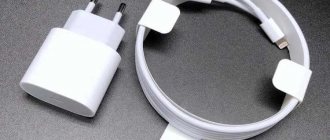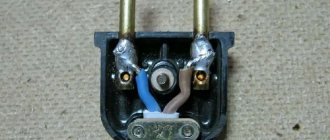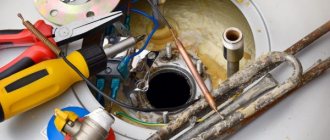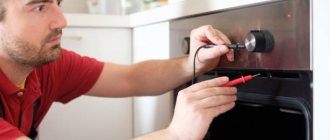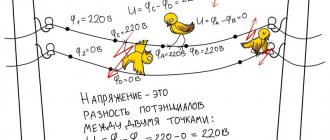The main reason that welding suddenly begins to “work” inside the microwave, that is, it begins to spark and crack terribly, is that the plate, which is located inside the chamber itself and which is easy to see with the naked eye, has burned out. What does a prudent owner do in this case? The inefficient person goes to buy a new microwave, which is what manufacturers are counting on. A real man will find a way to fix it.
So, let's begin. We shoot this record right in the camera. It looks like a bank card with a metallic sheen and is scientifically called microwave mica). On many models it is simply attached to the side with an adhesive solution and can be removed very easily. If the model is not the same, we look for a way to remove it (you need a screwdriver and a hammer (just kidding)).
We cut off strips from it on the sides, of such a width to cover the burnt area, usually it is small, and place it on this area. Attach with adhesive tape. That's it - the microwave again works as well as before, without crackling or sparking, and also without loss of power and harm to the body.
And how many people have thrown out microwave ovens precisely because of this problem.
By the way, I haven’t checked it myself, but they say that these plates can be bought for literally pennies and they are sold in almost any market or in repair shops. Well, this is for those who want a new one, and for those who don’t have time, like me, the old one will be repaired.
By the way, it helps to simply seal the place where the burnt plate was with a medical adhesive plaster (i.e., the microwave will work without the “original” plate at all, the main thing is that this place is sealed.
PS I checked the work without a plate and an adhesive plaster at all - it works without a plate and without an adhesive plaster)))
All the best
PPS: Watch another video on this topic:
How a microwave oven works and works
MAGNETRON POWER SUPPLY
The magnetron power supply provides the generation of supply voltages: Anode voltage Ua = 4000 volts A = 300 mA. Filament voltage U = 3.15 volts A = 10 Amperes.
220 volts are supplied through a special control circuit to the primary winding of the power transformer. Next, using a power transformer (which also acts as a stabilizer), the voltage is supplied to the voltage doubling circuit assembled at VD1, C1. Resistance R1 has a rating of 1 to 10 MΩ and is needed to ensure the discharge of capacitor C1 when the stove is turned off. In imported capacitors, the resistor is mounted inside. Safety diode VD2 (fuse diode) serves to protect the transformer from overheating in the event of a short circuit in the magnetron or an excessive increase in the voltage on capacitor C1. Works for breakdown like P2M in Funai TV. When a short circuit occurs, the current in the secondary windings sharply increases, which leads to an increase in the current in the primary windings and the fuse blows. This diode can be neglected i.e. do not install it, but in this case it is necessary to install the fuse strictly according to the nominal value. There have been cases when we received furnaces with a removed fuse diode and a fuse made from a nail. After such a repair, there is no protection left and the poor transformer looks like melted cheese. If you measure the voltage at the cathode of the magnetron it will be exactly -4000 volts (negative), then at the anode relative to the cathode the voltage will be exactly +4000 volts.
Read also: Compressor unit lubrication system
MAGNETRON
1. The metal cap is mounted on a ceramic insulator 2. 3. The outer casing of the magnetron 4. A flange with holes for mounting. 5 Ring magnets serve to distribute the magnetic field. 6. Ceramic cylinder for antenna insulation. 7. The radiator serves for better cooling. 8. Filter box. 9. The connection unit between the magnetron and the power source contains transition capacitors, which together with the chokes form a microwave filter to protect against the penetration of microwave radiation from the magnetron. 10. Power terminals.
A magnetron is a vacuum diode, the anode of which is made in the form of a copper cylinder. I will not go into details of the operation of the magnetron, I will only say that the operating voltage of the magnetron anode ranges from 3800 to 4000 volts. Power from 500 to 850 Watts. Filament voltage is from 3.15 to 6.3 volts. The magnetron is mounted directly on the waveguide. In those furnaces where the manufacturer has a magnetron with a short waveguide, a defect such as a breakdown of the mica gasket can be observed. This happens as a result of contamination of the gasket. Now the price of a mica gasket is in the range of 40-50 rubles. You can cut the gasket using ordinary scissors.
Magnetron defects: 1. When the gasket breaks down, there are often cases when the cap melts. Can be replaced with a cap from another magnetron. 2.Like any lamp, it can lose its emission, as a result of which the energy output is significantly reduced and the cooking time increases. You can increase the service life of the magnetron by adding filament voltage. To do this, you need to wind up 0.5 turns of the filament winding. (in some cases it is possible to extend the service life to 3 years) 4. Breakdown of transition capacitors can be detected using a tester. The breakdown occurs on the magnetron housing. It can be treated by replacing node 9 (see figure).
When replacing the magnetron, you must strictly follow the rules. 1. The antenna diameter and fasteners must exactly match the original. 2. The magnetron must be in close contact with the waveguide. 3. The length of the antenna must exactly match the original. 4. The magnetron power must be the same.
The price of a magnetron on the radio market is from 47 to 70 dollars. It is better to buy magnetrons from companies that will give you the opportunity to exchange them if, for example, the seat does not fit.
HIGH VOLTAGE DIODE
It is a large number of diodes connected in series in one housing. It is impossible to check with a tester. But there is one method that allows you to check a diode with a certain accuracy. If you connect it according to this diagram. The measurement is carried out in two directions, for which the diode must be turned over.
SAFETY PRECAUTIONS WHEN WORKING WITH MICROWAVE OVENS
1. Do not turn on the oven with the door or screen open.
2. Do not make holes in the housing.
3. When replacing the magnetron, be especially careful. Do not leave installation debris in the waveguide. The debris will cause microwave waves to ripple in the waveguide and, as a result, the microwave oven will emit radiation (like a nuclear reactor).
4. Always discharge the capacitance in the magnetron power circuits with a piece of insulated wire (the resistor sometimes fails).
The simplest circuit for detecting microwave radiation.
All information was taken from the Telemaster website
In the comments to the article you can ask questions about the repair of microwave ovens. The question format should be as follows:
- Name, model, year of manufacture
- What have you done already? What did you check? Provide control measurements and other information.
- Are there any elements with visible damage?
- What measuring equipment do you have?
- And other detailed information
Read also: Hammer handle increases impact force
If this information is missing, your comment will likely not pass moderation and will be deleted.
Microwave ovens are complex electrical appliances that can also pose a danger to the user. In normal operating condition, the kitchen unit does not pose a threat, but failure of its functional elements makes further operation unsafe. The difficulty in troubleshooting lies in the fact that one sign of a breakdown can have several causes. If the microwave sparks, this may indicate various problems in the device. Before you begin repairs, you should understand the situation in more detail.
Causes of malfunction
There can be several reasons for the problem – from mechanical damage to overheating of some parts of the microwave. In particular, burnout of the mica diffuser is the most common. Unfortunately, this problem occurs in all types of such furnaces, and it is quite difficult to insure against it. Problems of this kind are not associated with gross malfunction of the device and more often arise due to the poor quality of the element itself. Also, if the microwave sparks when turned on, this may be a sign of damage to the internal surfaces in the chamber itself. The fact is that the inside of microwave ovens is treated with special enamel coatings. Deformation of this layer usually occurs as a result of the use of metal utensils. That is, breakdowns of this kind can be prevented if the basic rules for operating an electrical appliance are followed. By the way, it is undesirable to use ceramic dishes with metallized coatings for heating in the microwave.
Where does the current come from on the body and drum?
Taking into account the above, a logical question arises: where can life-threatening voltage appear in the washing machine?
Beware of leakage current, which may occur in the following cases:
- Natural appearance due to the design features.
- Damage to household appliances caused by a violation of the integrity of the insulation.
- Violation of the integrity of the wires that fit into the outlet, or damage to the outlet.
The leakage current mentioned in point 1 is not dangerous. Its value is no more than 10 mA, which is not capable of causing harm to humans.
It is present in almost all electrical appliances, even those that are fully functional.
As for the currents arising due to equipment breakdowns, they are large and, accordingly, carry a certain danger.
If you touch elements of household appliances, for example, a drum, faucet, body or tap water, a leakage current appears. It follows the path of least resistance and through the human body.
The path most often serves as an arm, a leg and the ground. With high current readings, you can feel real discomfort, tingling, pain.
In practice, leakage current can also appear on other objects that are in the washing machine. The only condition is the ability of the element to conduct current.
In this case, a completely different chain may arise, for example, a washing machine, a filler tube, pipes and a bathtub. If a person touches the bathtub in this case, he will receive an electric shock.
To avoid such problems, it is necessary to install an RCD at the entrance to the apartment/house.
All large elements of household appliances must be connected to it: washing machine, dishwasher, boiler, electric stove, etc.
In this case, the natural current leaves through the grounding wire, but at a high current (above the RCD setting), the disconnecting equipment is triggered. In this case, the “Residual Shutdown Device” reacts to the difference in currents at the input and output.
Therefore, if you connect the washing machine correctly, it will not give you an electric shock. If this happens, you need to look for problems with the wiring.
If the connection is incorrect, the current will accumulate on the metal body and any time you touch it with your hand or other part of the body, you can feel its effect.
If the RCD is missing or faulty, and there is no grounding in the apartment, you can find yourself under high voltage, and the current will be sufficient to cause serious harm, even death.
What exactly sparks?
To understand the causes of this problem, you need to understand the very nature of sparking. So, if the microwave sparks and crackles, this means that there is an interaction process between two electrical conductors inside. In other words, conditions were created for the formation of an electrical discharge or arc. Such phenomena can be accompanied not only by sparking and crackling, but also by light effects, which looks even more frightening.
What elements in this case provoked the sparking? These may well be metal elements that ended up in the chamber with the dishes. Again, it doesn't have to be all metal utensils. If a microwave with a ceramic plate sparks, it may be due to pieces of foil. Moreover, a charge does not always occur even if there are full-fledged metal parts in the chamber. To activate such processes, there must be appropriate power, which will be enough to overcome the barrier in the form of an air dielectric.
Troubleshooting
If you have basic knowledge of electrical engineering, you can try to independently determine the source of current leakage. To do this, you will need a multimeter with a megohmmeter function. Diagnostics consists of several stages:
Disconnecting the stove from the network;
Inspection of electrical wiring insulation (if there are any exposed wires);
Sequential shutdown of functional units (relay, thermostat) in order to find out the location of the leak. It is necessary to disconnect components until the resistance level is restored to an acceptable value;
Any manipulation with electric current poses a serious danger to life. If you do not have the appropriate experience and qualifications, call a specialist to your home who will conduct diagnostics and accurately recognize the vulnerability. Servicing electric stoves at home can only be carried out by electricians with a safety group of at least III, who know the design of electric stoves and have access to equipment with voltages up to 1000 volts.
When inspecting and servicing the electric stove, all precautions should be taken. You can inspect and replace the internal components of the stove if it is turned off and de-energized. It is prohibited to carry out any manipulations with the switched on electric stove in damp clothes or shoes, as well as barefoot and with wet hands.
Can I use a sparkling stove?
The answer to this question depends on the condition of the microwave oven and its components. The mere fact of sparking does not always indicate damage to the same diffuser or enamel coating. Another thing is that the appearance of sparks should be a reason for a comprehensive inspection of the device. That is, if the cause of this phenomenon was the very presence of a metal element in the chamber, then further operation is quite acceptable provided that the functional contents of the device are intact. But in any case, it is important to stop the heating process if the microwave sparks. What to do in such situations? First of all, turn off the device through the control system. Next, the power supply is turned off. After this, the working elements are checked, among which the most important will be the magnetron - the most expensive and critical part of the microwave.
Read also: Gear ratio of the Ural chainsaw
Why you shouldn’t do zeroing and DSUP in the TN-C system
So, we have come to the point that grounding is necessary. However, in houses built before the mid-90s, the TN-C system is implemented. This means that the conductor of the working solidly grounded zero also performs the protective function of PE (grounding). Therefore, it is called PEN (protective zero PE + working zero N) and is not divided along its entire length from the transformer substation to the floor switchboard. Therefore, there is no grounding in the floor panel, there is only a PEN bus. Connecting the protective (third) conductor of the apartment electrical wiring to the PEN in the floor panel is called “grounding”.
I don’t want to throw too much water on this matter, it’s worth taking a look at the pictures below. The principle demonstrates the consequences of damage to the PEN conductor. The pictures show grounding in the junction box (I strongly do not recommend doing this), but they demonstrate the essence - safety will not be particularly improved by grounding in the switchboard.
It is worth noting that the burning of the zero at the transformer substation, which electricians are afraid of, is not the only reason to be afraid of zeroing. Elementary contact between a floor electrical panel and a conductive PEN conductor is very unreliable, given decades of operation.
The photo below is an example of an unreliable connection, just think: if you zero electrical appliances in the bathroom to such a contact, as soon as it warms up or oxidizes a little more, the housings of all working, “zeroed” appliances will be under a voltage of 380 volts!
After all, this working zero provides a voltage of 220 volts between one of the three phases and the PEN bus, when the contact with it is destroyed on the floor panel, then two apartments (or three) are connected in series to two phases (or three).
I hope I have given enough arguments for the reader to refuse nullification. It’s sad, but you shouldn’t count on high-quality grounding until the home energy system is reconstructed. Until this moment, it is better to live without grounding at all.
Some inquisitive minds may think: What if you make a grounding and, in addition, build a DSUP in the bathroom? After all, even if a phase appears on the protective conductor, all metal objects in the bathroom will also have phase voltage and there will be no conditions for current to flow through the body!
Indeed, if all conductive objects, including the bathroom floor fittings, operate at the same potential, the person there will be safe... Until he crosses the potential equalization zone. Moreover, in such a situation the neighbors will certainly suffer. Therefore, it is strictly prohibited to perform potential equalization in an apartment using the TN-C system.
Naturally, water pipes, heating pipes, or fittings protruding from the wall also cannot be used for grounding.
This is not possible, it is prohibited - so what to do if there is no grounding in the apartment?
Checking the magnetron
This operation is performed by electrically ringing the contacts of the part. The contacts of the high-voltage transformer are connected to the magnetron - they should be checked for functionality. Masters usually examine such areas for the presence of resistance, and the electromagnetic responsiveness of the device body is also assessed. If there is activity, then the magnetron is fine and does not need to be replaced. But even with a working magnetron, you can observe how the microwave sparks. What to do in such cases? You should begin to inspect the mica diffuser and the condition of the enamel coating.
What can't you do?
People ignorant of electrical engineering often look for advice on the Internet. Some of them are absurd and even dangerous. Here are not the most useful recommendations:
- Disable the surge protector. The danger of defeat is not eliminated.
- Connect the ground wire to the heating radiator. This is very bad advice and increases the likelihood of failure.
To ensure that your washing machine is a source of comfort and not electricity, take its connections seriously. By ensuring reliable grounding of household appliances and installing a protective device, you will eliminate the possibility of damage.
Bad 3
Interesting 4
Super 1
Mica diffuser repair
The microwave diffuser is a mica plate which, if damaged or excessively dirty, can cause sparking. This is a small part that can be repaired on its own if the microwave sparks when turned on. The repair will consist of updating this component. It is necessary to purchase a diffuser that matches the characteristics at the service center of the manufacturer of a specific model or on the radio market and replace the old plate with it. Moreover, sometimes experts recommend not dismantling the old mica plate, but only installing a new element and first cleaning the installation site.
Restoring the enamel coating
The formation of sparks can also result from mechanical damage to the enamel-treated chamber walls. The latter is used not only to form dielectric insulation, but also to maintain surface cleanliness. During operation, it is quite possible that this layer may be damaged by the edges of the dishes or as a result of careless movements with food. If after such manipulations the microwave sparks, it means that the insulating coating has been damaged and needs to be restored. Damaged areas are repaired using specialized environmental compounds. The working surface is first cleaned, after which new enamel is applied in accordance with the instructions.
Other measures if the washing machine begins to shock
If a malfunction occurs, the first thing to do is to remove the voltage by pulling the plug from the socket and turning off the power in the panel or the general circuit breaker (if a separate one is not provided).
Then inspect the outlet. If this is the source of the problem, replace the device yourself or get help from an electrician.
If there are no complaints about the outlet, you need to call a washing machine repairman.
In the future, it is important to connect household appliances correctly to avoid such problems.
Follow these guidelines:
- Plug the washing machine into an outlet that is grounded and has a separate CB and RCD. In 1- and 2-room apartments you can install one residual current device at the entrance.
- Do not use a baby carrier. This is due to the fact that such devices are not designed to power high-power equipment and often do not have a ground wire. Consequently, the excess current does not go anywhere, but is collected on the body of the washing machine.
- Install, at a minimum, an RCD in the absence of protective grounding. In this case, you can protect yourself from dangerous leakage currents. At the same time, it is not necessary to install it throughout the entire apartment - it is enough to do this only for the washing machine and other equipment that can receive electric shock.
How to avoid microwave sparking?
It has already been noted that sparking occurs either due to low-quality components or due to violations of operating rules. To minimize such risks, other recommendations for using such ovens should also be followed. For example, you should not heat food without covering it with a special lid - splashing greasy particles, for example, can contribute to the same damage to the enamel. The microwave often sparks due to excessive contamination of the mica plate itself. It may be intact, but dirty. In this case, it is not necessary to purchase a new element - it is enough to carry out timely care of the mica surface.


